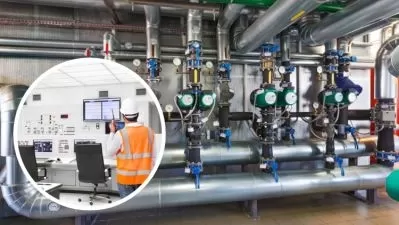Mastering REF Protection: Advanced Calculations
Elite Engineering
1:00:11
Description
In-Depth Calculation Techniques for Electrical Engineers: Led by a 21-Year Industry Veteran
What You'll Learn?
- Basics of REF protection
- REF scheme operation
- Current transformer requirements
- Calculations of REF relay
Who is this for?
What You Need to Know?
More details
DescriptionWelcome to "Mastering Calculations of Restricted Earth Fault (REF) Protection," an advanced online course tailored for electrical engineers, protection specialists, and technical professionals involved in the design, implementation, and maintenance of protective relay systems. This course provides an in-depth understanding of the calculations and principles underlying REF protection, ensuring you have the expertise to enhance system reliability and safety.
Trainer Introduction:
Your trainer brings over 21 years of rich experience in operation & maintenance, erection, testing, project management, consultancy, supervision, substation automation, SCADA, and commissioning. With a background spanning power plants, high voltage substations, and HVDC installations, he has worked with renowned organizations such as Siemens Saudi Arabia. He has been involved in over 20 high-voltage substation projects across Pakistan and Saudi Arabia.
His expertise encompasses a wide range of areas including protection systems, substation automation systems, design, testing, and commissioning of power generation systems, high voltage switchgear, protection relays, and control schemes. He has a proven track record of leading testing and commissioning teams for implementing electrical infrastructure projects for industrial clients, including steel and petrochemical industries.
Course Modules:
1. Introduction
Begin with an overview of Restricted Earth Fault (REF) protection, its significance in electrical power systems, and the importance of accurate calculations to ensure effective protection.
2. What is Differential Protection?
Learn about the fundamentals of differential protection, its role in detecting faults within a specified zone, and how it differs from other types of protection schemes.
3. Differences Between High and Low Impedance Differential Protection
Explore the key differences between high impedance and low impedance differential protection schemes, including their applications, advantages, and limitations.
4. Basic REF Scheme
Understand the components and configuration of a basic REF protection scheme. Learn how these elements work together to provide reliable fault detection and isolation.
5. Collection of CT Data
Discover the importance of accurate Current Transformer (CT) data collection. Learn the methods for gathering essential CT information required for REF protection calculations.
6. Current Transformer Requirements
Delve into the specific requirements for CTs used in REF protection. Understand the critical parameters and characteristics that influence CT performance and protection accuracy.
7. CT Class Requirements
Gain insights into the various CT classes and their relevance to REF protection. Learn how to select the appropriate CT class to meet the protection scheme's requirements.
8. Conditions for Stable REF Protection
Explore the conditions necessary for achieving stable REF protection. Understand the factors that influence stability and how to ensure your protection scheme remains robust under different operating conditions.
9. Calculation of Operating Current
Learn how to calculate the operating current for REF protection. Understand the principles and formulas used to determine the appropriate operating current for reliable fault detection.
10. Calculation of Stability Voltage
Understand the importance of stability voltage in REF protection. Learn how to calculate stability voltage to ensure the protection scheme remains stable and avoids unnecessary tripping.
11. Calculation of Stabilizing Resistor
Discover the role of the stabilizing resistor in REF protection schemes. Learn how to calculate the value of the stabilizing resistor to enhance protection stability and performance.
12. Calculation of Metrosil
Understand the function of Metrosil (a nonlinear resistor) in REF protection. Learn how to calculate and select the appropriate Metrosil to protect CTs from high transient voltages and ensure accurate operation of the protection scheme.
Learning Outcomes:
By the end of this course, participants will:
Master the calculations and principles of Restricted Earth Fault (REF) protection.
Understand the fundamentals and differences between high and low impedance differential protection.
Design and implement a basic REF protection scheme.
Collect and analyze essential Current Transformer (CT) data.
Ensure CTs meet the necessary requirements and select the appropriate CT class.
Identify and maintain the conditions for stable REF protection.
Calculate operating current, stability voltage, stabilizing resistor, and Metrosil for effective REF protection.
Target Audience:
This course is ideal for:
Electrical engineers
Protection and control engineers
Substation and power system designers
Maintenance engineers
Technical consultants
Anyone involved in the design, implementation, and maintenance of protective relay systems
Enroll now and gain the expertise to master the calculations of Restricted Earth Fault Protection, ensuring the safety and reliability of electrical power systems.
Who this course is for:
- Electrical engineers Protection and control engineers Substation and power system designers Maintenance engineers Technical consultants Anyone involved in the design, implementation, and maintenance of protective relay systems
Welcome to "Mastering Calculations of Restricted Earth Fault (REF) Protection," an advanced online course tailored for electrical engineers, protection specialists, and technical professionals involved in the design, implementation, and maintenance of protective relay systems. This course provides an in-depth understanding of the calculations and principles underlying REF protection, ensuring you have the expertise to enhance system reliability and safety.
Trainer Introduction:
Your trainer brings over 21 years of rich experience in operation & maintenance, erection, testing, project management, consultancy, supervision, substation automation, SCADA, and commissioning. With a background spanning power plants, high voltage substations, and HVDC installations, he has worked with renowned organizations such as Siemens Saudi Arabia. He has been involved in over 20 high-voltage substation projects across Pakistan and Saudi Arabia.
His expertise encompasses a wide range of areas including protection systems, substation automation systems, design, testing, and commissioning of power generation systems, high voltage switchgear, protection relays, and control schemes. He has a proven track record of leading testing and commissioning teams for implementing electrical infrastructure projects for industrial clients, including steel and petrochemical industries.
Course Modules:
1. Introduction
Begin with an overview of Restricted Earth Fault (REF) protection, its significance in electrical power systems, and the importance of accurate calculations to ensure effective protection.
2. What is Differential Protection?
Learn about the fundamentals of differential protection, its role in detecting faults within a specified zone, and how it differs from other types of protection schemes.
3. Differences Between High and Low Impedance Differential Protection
Explore the key differences between high impedance and low impedance differential protection schemes, including their applications, advantages, and limitations.
4. Basic REF Scheme
Understand the components and configuration of a basic REF protection scheme. Learn how these elements work together to provide reliable fault detection and isolation.
5. Collection of CT Data
Discover the importance of accurate Current Transformer (CT) data collection. Learn the methods for gathering essential CT information required for REF protection calculations.
6. Current Transformer Requirements
Delve into the specific requirements for CTs used in REF protection. Understand the critical parameters and characteristics that influence CT performance and protection accuracy.
7. CT Class Requirements
Gain insights into the various CT classes and their relevance to REF protection. Learn how to select the appropriate CT class to meet the protection scheme's requirements.
8. Conditions for Stable REF Protection
Explore the conditions necessary for achieving stable REF protection. Understand the factors that influence stability and how to ensure your protection scheme remains robust under different operating conditions.
9. Calculation of Operating Current
Learn how to calculate the operating current for REF protection. Understand the principles and formulas used to determine the appropriate operating current for reliable fault detection.
10. Calculation of Stability Voltage
Understand the importance of stability voltage in REF protection. Learn how to calculate stability voltage to ensure the protection scheme remains stable and avoids unnecessary tripping.
11. Calculation of Stabilizing Resistor
Discover the role of the stabilizing resistor in REF protection schemes. Learn how to calculate the value of the stabilizing resistor to enhance protection stability and performance.
12. Calculation of Metrosil
Understand the function of Metrosil (a nonlinear resistor) in REF protection. Learn how to calculate and select the appropriate Metrosil to protect CTs from high transient voltages and ensure accurate operation of the protection scheme.
Learning Outcomes:
By the end of this course, participants will:
Master the calculations and principles of Restricted Earth Fault (REF) protection.
Understand the fundamentals and differences between high and low impedance differential protection.
Design and implement a basic REF protection scheme.
Collect and analyze essential Current Transformer (CT) data.
Ensure CTs meet the necessary requirements and select the appropriate CT class.
Identify and maintain the conditions for stable REF protection.
Calculate operating current, stability voltage, stabilizing resistor, and Metrosil for effective REF protection.
Target Audience:
This course is ideal for:
Electrical engineers
Protection and control engineers
Substation and power system designers
Maintenance engineers
Technical consultants
Anyone involved in the design, implementation, and maintenance of protective relay systems
Enroll now and gain the expertise to master the calculations of Restricted Earth Fault Protection, ensuring the safety and reliability of electrical power systems.
Who this course is for:
- Electrical engineers Protection and control engineers Substation and power system designers Maintenance engineers Technical consultants Anyone involved in the design, implementation, and maintenance of protective relay systems
User Reviews
Rating
Elite Engineering
Instructor's Courses
Udemy
View courses Udemy- language english
- Training sessions 11
- duration 1:00:11
- Release Date 2024/10/29











